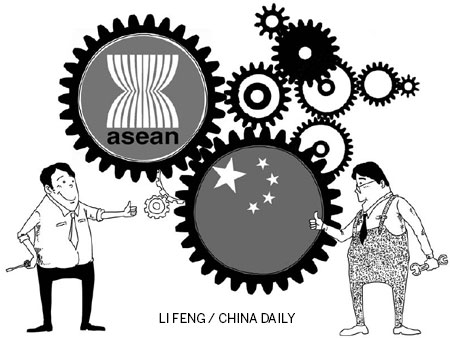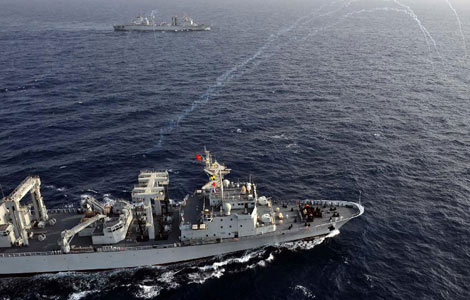How to build a sea of peace and amity
Updated: 2013-08-28 07:55
By Jin Yongming (China Daily)
|
||||||||

The Special China-ASEAN Foreign Ministers' Meeting, to be held in Beijing on Aug 29 to mark the 10th anniversary of the establishment of the China-ASEAN strategic partnership, will focus mainly on deepening of relations between the two sides.
China and some ASEAN member states have been involved in territorial disputes in the South China Sea. To defuse the tensions, however, Foreign Minister Wang Yi has proposed that the parties work out a Code of Conduct and ensure the success of the Beijing meeting on the key documents related to dispute management .
Wang's proposal has four key elements. First, each party should have a realistic expectation from the talks. He said that it would be neither realistic nor serious to talk about a "quick fix (solution)". Since a COC concerns the interests of all the parties, its formulation will be a process of sophisticated and complex coordination.
Second, to reach a consensus on a COC, the parties should draw inspiration from the Declaration on the Conduct of Parties in the South China Sea (DOC) to push ahead the consultations on a COC. The idea, however, should be to seek a broad consensus to take care of the interests of all parties and ensure that no party imposes its will on others.
Third, China and ASEAN member states should prevent non-regional countries from interfering in their disputes. The interference of external parties has for years thwarted the efforts of China and ASEAN members to give shape to a COC. For instance, a joint working group was founded in 2004 for the implementation of the DOC, followed by eight meetings since 2005. But these efforts have failed to facilitate an agreement on a regional COC because of some irrelevant parties' interference. So China and ASEAN member states should make concerted efforts to build an atmosphere conducive to the formulation of a COC.
Fourth, the two sides should take a step-by-step approach to formulate a COC. The South China Sea disputes are extremely sensitive and cannot be resolved overnight. Therefore, the two sides have to work on a COC within the framework of the DOC and keep in mind that a COC is not intended to replace the DOC.
Wang's four-point proposal is based on international laws. It conforms to the guidelines for the implementation of the DOC that China and ASEAN member states agreed upon in 2011. The proposal is consistent with Beijing's long-held stance that China and ASEAN member states should resolve the maritime disputes step by step.
Besides, the two sides should cooperate in less sensitive fields to build mutual trust. And based on enhanced mutual trust and maritime cooperation in less sensitive fields, the two sides should make further efforts to enact legally binding agreements such as a COC.
Of course, it will take time for the complete resolution of the disputes, but that does not mean the parties cannot seek ways of common development on a mutually beneficial basis. As Wang said, joint development is not only for economic interests, but also to show the rest of the world that the disputing countries are willing to resolve the disputes through peaceful means.
China's approach to the disputes meets the basic requirements for the exploration and exploitation of resources in the South China Sea. On the one hand, all the parties have the right to exploit resources in the region, especially through deeper cooperation in less sensitive fields. On the other hand, the parties should make joint efforts to enact legally binding documents like a COC for reasonable exploitation of the marine resources.
This is particularly important because the DOC has some technical problems when it comes to implementation; it cannot help resolve the disputes because of its non-legally binding nature.
A legally binding code can help regulate the activities of the countries in the region and ensure that the marine resources are exploited reasonably. For instance, although maritime cooperation in developing fishery resources is not included in the DOC, China and ASEAN member states can hold discussions to establish a regional cooperation framework for fishery resources management and emergency response. This will not only protect the rights of fishermen, but also prevent further disputes, which in the past have been mostly triggered by incidents involving fishermen.
The formulation of a COC will accelerate the process of building a sound legal regime in the South China Sea for the common interests of all stakeholders. As always, China will strive to make its due contribution to regional peace and stability and realize its goal of evolving into a regional maritime power.
The author is the director of the Center for China Marine Strategy Studies, Shanghai Academy of Social Sciences.
(China Daily 08/28/2013 page9)

 US preparing for probable strike on Syria
US preparing for probable strike on Syria
 Putting money on full moon
Putting money on full moon
 Language list aims to pass on Chinese culture
Language list aims to pass on Chinese culture
 Cancer patient delivers healthy baby
Cancer patient delivers healthy baby
 Chinese navy starts escort mission at Gulf of Aden
Chinese navy starts escort mission at Gulf of Aden
 McGrady retires, considers career in China
McGrady retires, considers career in China
 Li Na breezes into US Open second round
Li Na breezes into US Open second round
 China and India set to resume military drills
China and India set to resume military drills
Most Viewed
Editor's Picks

|

|

|

|

|

|
Today's Top News
Affluent Chinese pursue overseas properties
Sino-Japanese meeting at G20 ruled out
New time limits for visa processing
China joins global effort to combat tax evasion
Party's plenum to focus on reform
Chinese negotiator in DPRK
Nursing homes to give Tibetans care
WeChat users under scrutiny
US Weekly

|

|







